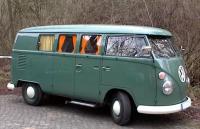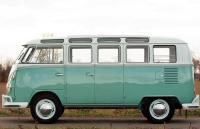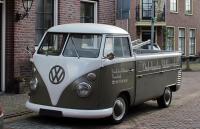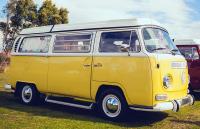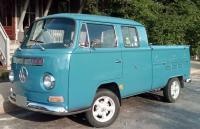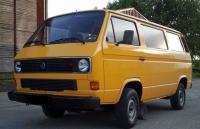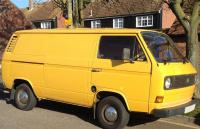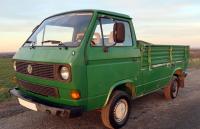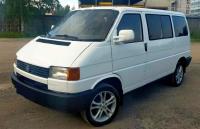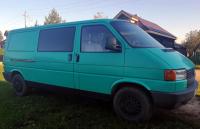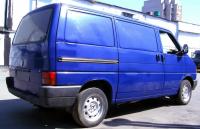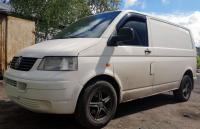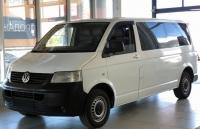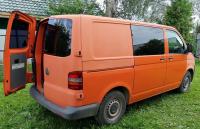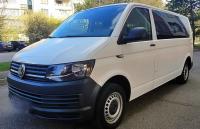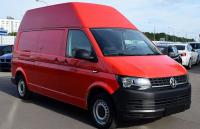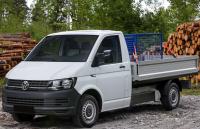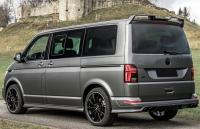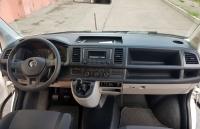The main competitors and classmates of the Transporter today are Citroen Jumpy, Fiat Talento, Ford Transit, Hyundai iLoad, Mercedes-Benz Vito/Viano, Nissan NV300, Opel Vivaro, Peugeot Expert, Renault Trafic, Toyota Hiace, Toyota ProAce.
Type 2 - T1 (1950–1967)
For the first time the idea to create a small commercial van arose in 1947, when the Dutchman Ben Pon saw at the factory in Wolfsburg a car designed to drive around the plant and transport small loads. It was made on the basis of a small car «VW Beetle» and rear driver's seat. The idea of creating a commercial van seemed promising, since post-war Europe was badly destroyed and many trucks would be needed to restore it. A production model with a front driver was introduced in November 1949.
The first generation of the minibus appeared in March 1950 to the end of 1967. The car had a windshield divided into two segments, so he received the nicknames «Splitscreen», «Splittie» and «Microbus». Until 1956, production was at the plant in Wolfsburg, and after that it was transferred to a completely new plant in Hannover. In Brazil, this generation was produced until 1975. During the first year, more than 9 thousand cars were produced. Body options were as follows - a four- or five-door van, minibus, high-roof van, two- or three-door pickup, camper and others. Rear engine with rear wheel drive. The length of the car was 4280 mm, width 1750 mm, height 1920 mm, wheelbase 2400 mm and curb weight from 890 kg.
Engines were installed only gasoline four-cylinder with opposed cylinders and air cooling, mounted in the rear of the car. First there was a 1.1 liter engine (1131 cm3) with a capacity of 24 hp, In 1953, its volume was increased to 1.2 liters (1192 cm3) 30 hp, which was increased to 41 hp in 1955. by increasing the compression ratio. In 1963, a 1.5-liter engine appeared (1493 cm3) 52 hp. The gearbox was only a mechanical four-speed.
Type 2 - T2 (1967–1979)
In August 1967, the second generation of the van appeared «Type 2». Pre-1971 models often referred to as T2a (Early Bay), and models after 1972 - T2b (Late Bay). The characteristic windshield segmented into two parts has become solid. The onboard electrical system has been upgraded from 6 volts to 12 volts. The external dimensions of the car became larger and it became heavier. Body length was 4505 mm, width 1720 mm, height 1940-2040 mm, wheelbase 2400 mm and curb weight from 1105 kg. The body shapes were as follows - a van, a minibus, a loading platform, a flatbed truck, a camper and special vehicles for municipal needs.
The engines were also installed only gasoline with opposed cylinders and air cooling. At first the engine was 1.6 liters (1584 cm3) 48/50 hp, and after 1972 the engine compartment was enlarged, which made it possible to install larger 1.7-liter engines (1679 cm3) 66 hp, 1.8 liters (1796 cm3) 68 hp and 2.0 liters (1970 cm3) 71 hp. Models since 1975 began to be equipped with electronic fuel injection «Bosch L-Jetronic». The gearbox was at first the former five-speed manual, and since 1973 a three-speed automatic transmission has become available.
In 1972, they carried out minor changes in the appearance of the body and began to install bumpers from the profile, which increased safety in a collision.
Type 2 - T3 (1979–1992)
The third generation began to be produced in May 1979. It began to be sold under various names around the world − «Transporter» and «Caravelle» V Europe, «Microbus» in Africa, «Vanagon» in both Americas. The assembly was carried out in Germany and Africa, and since 1990 «T3» began to collect in South Africa. The car has become even larger, heavier and more angular than the previous generation. Its length began to be 4569 mm, width 1844 mm, height 1928-2085 mm, wheelbase 2461 mm and curb weight from 1395 kg. Body styles were minibus, van, flatbed truck with single or double cab, camper and municipal transport.
Throughout the production of the car, many different models of gasoline engines were installed on it. From 1979 to 1983 they installed air-cooled boxer engines from the previous generation with a volume of 1.6 liters (1584 cm3, CT, 50 hp) and 2.0 liters (1970 cm3, CU/CV 70 hp) with carburetor or fuel injection. Since 1983, only 1.9-liter water-cooled boxer gasoline engines have been installed (1913 cm3, DH (83 hp), DF (59 hp), DG (79 hp), EY (55 hp), GW (89 hp)) and 2.1 liters (2109 cm3, MV (95 hp), SS (90 hp), DJ (112 hp)) both with carburetors and with fuel injection. In January 1991, five-cylinder in-line engines began to be installed «Audi» 2.3 liters (AFU, 122 hp), 2.5 liters (AAY, 136 hp) and 2.6 liters (ADV, 136 hp).
Also, for the first time, 1.6-liter diesel four-cylinder engines began to be installed on this model (1588 cm3, CS, 50 hp), 1.6 liters (1588 cm3, JX, turbo, 70 hp) and 1.7 liters (1715 cm3, 57 hp). The transmission was a four- and five-speed manual, as well as a three-speed automatic. The drive was on the rear wheels, the production of an all-wheel drive model «Syncro» began at the end of 1984.
Unlike its predecessor, the car had modern comfort options, such as air conditioning, power steering, door locks and power mirrors, and some others.
Transporter T4 (1990–2003)
This is the first front-engined, front-wheel drive van from Volkswagen with the name «Transporter». Sold in the US and Canada under the name «EuroVan». The idea to make a powered van appeared in the late 1970s due to its rather successful use in passenger cars. It is not clear why the decision was made to release «T3» with rear engine and drive. The dimensions of the car continued to grow and the length began to be 4707 mm, width 1840 mm, height 1940 mm, wheelbase 2920 mm and curb weight from 1660 kg. There was a minivan variant with an extended wheelbase of 3320 mm and a body length of 5107 mm. There was also a van with a higher roof height of 2430 mm. Body options were - four-, five- or six-door minivan / van, pickup truck with a cargo platform and single or double cab, four-door camper.
Gasoline engines initially had two options, all in-line 2.0-liter (1968 cm3, AAC, SOHC 8v, I4, 84 hp) and 2.5 liters (2461 cm3, AAR / ACU, SOHC 10v, I5, 112 hp). The latter was replaced in 1997 with a 2.5 liter engine (2461 cm3, AET/APL/AVT, SOHC 10v, I5, 115 hp). In 1996, a 2.8-liter VR6 six-cylinder engine appeared (2792 cm3, AES, DOHC 12v, VR6, 140 hp), which in 2000 was replaced by 2.8 liters (2792 cm3, AES, DOHC 24v, VR6, 204 hp). Because of this engine, a serious facelift had to be done in 1996 in order for this engine to fit. So there was a model with an elongated nose.
Diesel engines with indirect injection were of the following characteristics - 1.9 liters (1896 cm3, 1 X, SOHC 8v, I4, 61 hp), 1.9 liters (1896 cm3, ABL, SOHC 8v, I4, turbo, 68 hp), 2.4 liters (2370 cm3, AJA/AAB, SOHC 10v, I5, 75/78 hp). Diesel engines with direct injection and turbocharging (TDI) there were three modifications, all in-line five-cylinders with a volume of 2.5 liters (2461 cm3, AJT/AYY, SOHC 10v, I5, 88 hp), 2.5 liters (2461 cm3, ACV/AUF/AYC/AXL, SOHC 10v, I5, 102 hp) and 2.5 liters (2461 cm3, AHY/AXG, SOHC 10v, I5, 151 hp).
The gearbox was a five-speed manual or four-speed automatic.
Transporter T5 (2003–2015)
Production of the fifth generation of the legendary commercial van with the number «T5» started in April 2003. A minivan for transporting people was sold under the names «Caravelle» and «Multivan», and a camper called «California». The dimensions of the body increased again and the length was 4890 mm, width 1904 mm, height 1935-2176 mm, wheelbase 3000 mm and curb weight from 1895 kg. Models with an extended wheelbase of 3400 mm were also produced, while the body length was 5920 mm. The body shapes were as follows - a utility van, a pickup truck with a single or double cab, a minibus, a loading platform, a camper and municipal special vehicles. Car load capacity varies from 800 to 1400 kg, cargo compartment volume from 5.8 to 9.3 m3. The assembly was carried out in Germany, Poland and Russia.
Gasoline engines installed the following volumes and characteristics - 2.0 liters (1984 cm3, AXA, I4, 116 hp), 2.0 liters (1984 cm3, CJKB/CJKA, I4, TSI turbo, 150/204 hp) and 3.2 liters (3189 cm3, BDL/BKK, VR6, 230/235 hp). Diesel engines were of the following parameters - 1.9 liters (1896 cm3, AXC/AXB/BRR/BRS, I4, 86/105/84/102 hp) and 2.5 liters (2461 cm3, AXD/BNZ/AXE/BPC, I5, 130/174 hp), After 2009, 2.0 liter diesel engines appeared (1968 cm3, EA189, I4, 84/102/114/140/180 hp). The gearbox was a five- or six-speed manual, as well as a six- or seven-speed automatic (DSG).
In September 2009, they released an updated line of the fifth generation of the Transporter. Updated diesel and gasoline engines, removed the gasoline VR6 with a volume of 3.2 liters. The car received many options previously only available on expensive sedans, such as a dual-clutch transmission (DSG), blind spot monitoring, tire pressure monitoring, bi-xenon headlights, daytime running lights, rear view cameras, touch screen and others.
The safety of the car was tested in 2008 and 2013 by the European committee «EuroNCAP», see the results in the tables below.
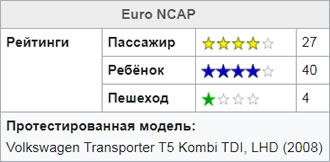 | 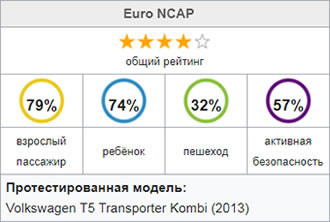 |
Transporter T6 (2015–present)
The sixth generation, which began production in 2015, was more like a deep restyling than a generational change. The hood, front fenders, bumpers, headlights, taillights and tailgate have undergone external changes. Inside, the steering wheel, instrument panel, auxiliary and entertainment systems have been changed, and noise isolation and suspension have also been improved. External dimensions and body options remained the same.
Gasoline engines remained virtually unchanged, while diesel engines were replaced by 2.0 liters (1968 cm3, EA288, I4, 84/102/114/150/199/204 hp) both single and twin turbo.
In 2019, another update of the model was carried out. The grille and headlights were replaced with narrower ones. Engines upgraded to meet emission standard «Euro 6». With electromechanical power steering, functions such as parking assistance, lane keep, and trailer reversing assistance became available.

